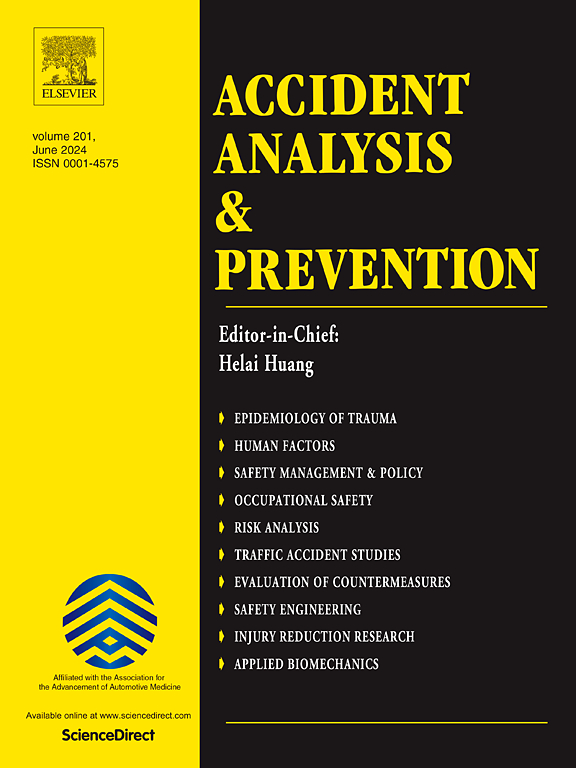Assessing the safety impacts of winter road maintenance operations using connected vehicle data
IF 5.7
1区 工程技术
Q1 ERGONOMICS
引用次数: 0
Abstract
This paper investigates the impacts of winter maintenance operations (WMO) on road safety under different weather conditions using connected vehicle data. In particular, the impacts of WMO on incident-induced delays (IID) and harsh braking events are highlighted, representing the influence on traffic flow and vehicle stability, respectively. Taking advantage of emerging connected vehicle data, the impacts of WMO on IIDs and vehicle harsh braking events are estimated. Data analysis revealed that WMO plays an important role in reducing the mean IID and the average number of harsh braking events, particularly when roads were covered with ice, frost, slush, or snow in snowy weather. The presence of WMO reduced the mean IID from 145.93 veh-h to 57.70 veh-h, representing a 60% decrease, and the number of harsh braking events from 3.58 cases per crash to 2.90 cases per crash, making a 19% reduction. Last, the multiple linear regression (MLR) model highlights that WMO effectively reduces IID by 23.36 veh-h. In addition, the MLR model indicates that IID is influenced by traffic volume, driving behaviors immediately before a crash, crash severity, road weather conditions, with more severe crashes and worse pavement conditions contributing to longer delays. These findings suggest that the WMO can improve road safety by reducing incident-induced delays and improving traffic stability in winter weather conditions.
利用联网车辆数据评估冬季道路维护作业的安全影响。
本文利用联网车辆数据研究了冬季维护作业(WMO)在不同天气条件下对道路安全的影响。特别强调了 WMO 对事故诱发延误(IID)和严重制动事件的影响,分别代表了对交通流量和车辆稳定性的影响。利用新出现的联网车辆数据,估算了 WMO 对事故诱发延迟(IID)和车辆严重制动事件的影响。数据分析显示,WMO 在减少平均 IID 和平均恶劣制动事件次数方面发挥了重要作用,尤其是在下雪天道路被冰、霜、泥泞或积雪覆盖时。WMO 的存在使平均 IID 从 145.93 车辆-小时下降到 57.70 车辆-小时,降幅达 60%;严重制动事件从每次碰撞 3.58 起下降到每次碰撞 2.90 起,降幅达 19%。最后,多元线性回归(MLR)模型显示,《世界气象组织》有效减少了 23.36 车辆-小时的 IID。此外,多元线性回归模型还表明,IID 受交通流量、车祸发生前的驾驶行为、车祸严重程度和道路天气条件的影响,车祸越严重、路面条件越差,延误时间就越长。这些研究结果表明,在冬季天气条件下,《世界气象组织》可以通过减少事故导致的延误和提高交通稳定性来改善道路安全。
本文章由计算机程序翻译,如有差异,请以英文原文为准。
求助全文
约1分钟内获得全文
求助全文
来源期刊

Accident; analysis and prevention
Multiple-
CiteScore
11.90
自引率
16.90%
发文量
264
审稿时长
48 days
期刊介绍:
Accident Analysis & Prevention provides wide coverage of the general areas relating to accidental injury and damage, including the pre-injury and immediate post-injury phases. Published papers deal with medical, legal, economic, educational, behavioral, theoretical or empirical aspects of transportation accidents, as well as with accidents at other sites. Selected topics within the scope of the Journal may include: studies of human, environmental and vehicular factors influencing the occurrence, type and severity of accidents and injury; the design, implementation and evaluation of countermeasures; biomechanics of impact and human tolerance limits to injury; modelling and statistical analysis of accident data; policy, planning and decision-making in safety.
 求助内容:
求助内容: 应助结果提醒方式:
应助结果提醒方式:


